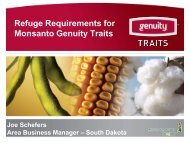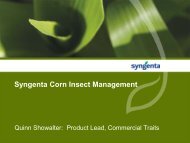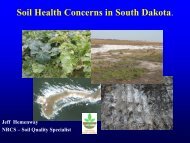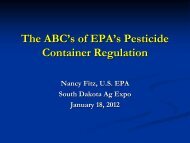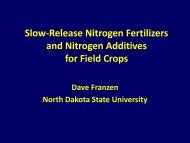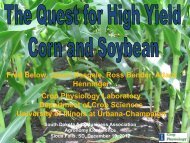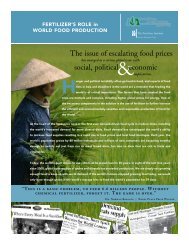The Quest for 300 Bushel Corn - South Dakota Agri-Business ...
The Quest for 300 Bushel Corn - South Dakota Agri-Business ...
The Quest for 300 Bushel Corn - South Dakota Agri-Business ...
- No tags were found...
Create successful ePaper yourself
Turn your PDF publications into a flip-book with our unique Google optimized e-Paper software.
Fred Below<br />
Crop Physiology Laboratory<br />
Department of Crop Sciences<br />
University of Illinois at Urbana-Champaign<br />
<strong>South</strong> <strong>Dakota</strong> <strong>Agri</strong>-<strong>Business</strong> Association<br />
Agronomy Conference<br />
Sioux Falls, SD, December 15, 2011
<strong>Quest</strong> <strong>for</strong> <strong>300</strong> <strong>Bushel</strong> <strong>Corn</strong><br />
•9 billion people by 2050<br />
requires a doubling of grain<br />
production including corn<br />
•<strong>300</strong> bu corn produced each<br />
year in the U.S. National<br />
<strong>Corn</strong> Growers Contest
<strong>Quest</strong> <strong>for</strong> <strong>300</strong> <strong>Bushel</strong> <strong>Corn</strong><br />
Herman<br />
Warsaw’s farm<br />
Saybrook, IL<br />
July 1985
<strong>Quest</strong> <strong>for</strong> <strong>300</strong> <strong>Bushel</strong> <strong>Corn</strong><br />
•Intelligent Intensification<br />
with the Seven Wonders of<br />
the <strong>Corn</strong> Yield World<br />
•What are the factors that<br />
have the biggest impact on<br />
corn yield each year
Seven Wonders of the <strong>Corn</strong><br />
Yield World<br />
•Ranks those factors that each<br />
year can have a positive (and<br />
sometimes negative) impact<br />
on corn yield<br />
•Gives each factor an average<br />
bushel per acre value
Crucial Prerequisites, but not<br />
Yield Wonders<br />
•Drainage<br />
•Pest/Weed Control<br />
•Proper soil pH & adequate<br />
levels of P and K based on<br />
soil tests
Seven Wonders of the <strong>Corn</strong> Yield World<br />
Rank<br />
1<br />
2<br />
3<br />
4<br />
5<br />
6<br />
7<br />
Factor<br />
Weather<br />
Nitrogen<br />
Value<br />
bu/acre<br />
70+<br />
70<br />
Given key prerequisites
220<br />
Weather and Nitrogen<br />
Grain yield (bu acre -1 )<br />
200<br />
180<br />
160<br />
140<br />
120<br />
2008<br />
2009<br />
100<br />
Same site – DeKalb, IL<br />
0 50 100 150 200<br />
Fertilizer N rate (lb acre -1 )
Weather and Nitrogen<br />
220<br />
Grain yield (bu acre -1 )<br />
200<br />
180<br />
160<br />
140<br />
120<br />
100<br />
80<br />
2006<br />
∆ Nitrogen<br />
2005<br />
∆ Weather<br />
0 50 100 150 200 250<br />
Same site – Champaign, IL<br />
Fertilizer N rate (lb acre -1 )
Seven Wonders of the <strong>Corn</strong> Yield World<br />
Rank<br />
1<br />
2<br />
3<br />
4<br />
5<br />
6<br />
7<br />
Factor<br />
Weather<br />
Nitrogen<br />
Hybrid<br />
Value<br />
bu/acre<br />
70+<br />
70<br />
50<br />
Given key prerequisites
Better N Use with Biotechnology Traits<br />
Grain yield (bu/acre)<br />
220 Hybrid Pair 1<br />
200<br />
180<br />
160<br />
140<br />
120<br />
Hybrid Pair 2<br />
Rootworm control<br />
Insecticide<br />
Biotech resistant<br />
0 50 100 150 200 250<br />
Fertilizer N rate (lb/acre)<br />
0 50 100 150 200 250<br />
Champaign, IL 2008
Greater Nutrient Removal with Grain as a<br />
Result of Biotechnology Traits<br />
Nutrient<br />
Non RW<br />
resistant<br />
Root worm<br />
resistant<br />
Difference<br />
bushels or lbs/acre removed %<br />
Yield 179 205 15<br />
N 110 126 14<br />
P 17 21 24<br />
K 26 31 19<br />
S 8.9 10.4 17<br />
Zn (oz) 2.2 2.8 27<br />
Champaign, IL 2008, average of two hybrid pairs
Seven Wonders of the <strong>Corn</strong> Yield World<br />
Rank<br />
1<br />
2<br />
3<br />
4<br />
5<br />
6<br />
7<br />
Factor<br />
Weather<br />
Nitrogen<br />
Hybrid<br />
Previous Crop<br />
Value<br />
bu/acre<br />
70+<br />
70<br />
50<br />
25<br />
Given key prerequisites
Previous Crop and N Response - 3 rd Year<br />
Grain yield (bu acre -1 )<br />
220<br />
200<br />
180<br />
160<br />
140<br />
120<br />
100<br />
80<br />
Average of 12 hybrids<br />
2006<br />
Previous Crop<br />
0 50 100 150 200 250<br />
Fertilizer N rate (lb acre -1 )<br />
<strong>Corn</strong> (3 nd year)<br />
Soybean
Previous Crop and N Response - 5 th Year<br />
Grain yield (bu acre -1 )<br />
220<br />
200<br />
180<br />
160<br />
140<br />
120<br />
100<br />
80<br />
Average of 15 hybrids<br />
2008<br />
Previous Crop<br />
0 50 100 150 200 250<br />
Fertilizer N rate (lb acre -1 )<br />
<strong>Corn</strong> (5th year)<br />
Soybean
Previous Crop and N Response - 7 th Year<br />
Grain yield (bu acre -1 )<br />
235<br />
210<br />
185<br />
160<br />
135<br />
110<br />
85<br />
60<br />
Average of four N sources<br />
2010<br />
Previous Crop<br />
0 50 100 150 200 250<br />
Fertilizer N rate (lb acre -1 )<br />
<strong>Corn</strong> (7th year)<br />
Soybean
Seven Wonders of the <strong>Corn</strong> Yield World<br />
Rank<br />
1<br />
2<br />
3<br />
4<br />
5<br />
6<br />
7<br />
Factor<br />
Weather<br />
Nitrogen<br />
Hybrid<br />
Previous Crop<br />
Plant Population<br />
Value<br />
bu/acre<br />
70+<br />
70<br />
50<br />
25<br />
20<br />
Given key prerequisites
Grain Yield is a Product Function<br />
of Yield Components<br />
Yield = (plants/acre) x<br />
(kernels/plant) x<br />
(weight/kernel)
Some Examples of Yield Component<br />
Combinations <strong>for</strong> Different Yields<br />
200 bushels =<br />
32,000 plants/ac x 550 kernels/plant x 250 mg/kernel<br />
250 bushels =<br />
36,000 plants/ac x 600 kernels/plant x 255 mg/kernel<br />
<strong>300</strong> bushels =<br />
45,000 plants/ac x 565 kernels/plant x 260 mg/kernel
Plant Competition Can Decrease Yield<br />
245<br />
Grain yield (bu acre -1 )<br />
230<br />
215<br />
200<br />
185<br />
170<br />
28 32 38 44 50<br />
Champaign, IL 2009<br />
Plant population (x10 3 acre -1 )
Are Twin Rows a way to increase<br />
Plant Population<br />
Champaign, 2009
Seven Wonders of the <strong>Corn</strong> Yield World<br />
Rank<br />
1<br />
2<br />
3<br />
4<br />
5<br />
6<br />
7<br />
Factor<br />
Weather<br />
Nitrogen<br />
Hybrid<br />
Previous Crop<br />
Plant Population<br />
Tillage<br />
Value<br />
bu/acre<br />
70+<br />
70<br />
50<br />
25<br />
20<br />
15<br />
Given key prerequisites
Seven Wonders of the <strong>Corn</strong> Yield World<br />
Rank<br />
1<br />
2<br />
3<br />
4<br />
5<br />
6<br />
7<br />
Factor<br />
Value<br />
bu/acre<br />
Weather<br />
70+<br />
Nitrogen<br />
70<br />
Hybrid<br />
50<br />
Previous Crop 25<br />
Plant Population 20<br />
Tillage<br />
15<br />
Growth Regulators 10<br />
Given key prerequisites
Leaf Greening from Strobliurin Fungicides<br />
Leaves greener 50 days after VT application
Seven Wonders of the <strong>Corn</strong> Yield World<br />
Rank<br />
1<br />
2<br />
3<br />
4<br />
5<br />
6<br />
7<br />
Factor<br />
Given key prerequisites<br />
Weather<br />
Nitrogen<br />
Hybrid<br />
Previous Crop<br />
Plant Population<br />
Tillage<br />
Growth Regulators<br />
TOTAL<br />
Value<br />
bu/acre<br />
70+<br />
70<br />
50<br />
25<br />
20<br />
15<br />
10<br />
260 bu
Seven Wonders of the <strong>Corn</strong> Yield World<br />
Rank<br />
1<br />
2<br />
3<br />
4<br />
5<br />
6<br />
7<br />
Factor<br />
Weather<br />
Nitrogen<br />
Hybrid<br />
Given key prerequisites<br />
Previous Crop<br />
Plant Population<br />
Tillage<br />
Growth Regulators<br />
TOTAL =<br />
Value<br />
bu/acre %<br />
70+ 27<br />
70 26<br />
50 19<br />
25 10<br />
20 8<br />
15 6<br />
10 4<br />
260bu 100%
How to Get <strong>300</strong> <strong>Bushel</strong>s<br />
• Provide better prerequisites,<br />
especially mineral nutrients<br />
• Optimize each of the seven<br />
wonders and their positive<br />
interactions
Prerequisites <strong>for</strong> <strong>300</strong> <strong>Bushel</strong>s<br />
• Proper soil pH & adequate<br />
levels of P and K based on<br />
soil tests<br />
• Fertility- Use technology to<br />
apply required amounts of<br />
nutrients each year, Sulfur<br />
& Micronutrients
Seasonal Uptake & Partitioning of Phosphorus<br />
Phosphorus Uptake (lb P ac -1 )<br />
45<br />
40<br />
35<br />
30<br />
25<br />
20<br />
15<br />
10<br />
5<br />
0<br />
Grain<br />
Tassel, Cob, Husk Leaves<br />
Stalk and Leaf Sheaths<br />
Leaf Blades<br />
0 500 1000 1500 2000 2500<br />
GDD F<br />
100<br />
75<br />
50<br />
25<br />
0<br />
Percent (%) of Total Phosphorus<br />
E V3 V6 V9 V14 V18 R1 R3 R5 R6<br />
6 hybrids Champaign and DeKalb, 2010<br />
Growth Stage
Seasonal Uptake & Partitioning of Zinc<br />
Zinc Uptake (oz Zn ac -1 )<br />
12.5<br />
10.0<br />
7.5<br />
5.0<br />
2.5<br />
Grain<br />
Tassel, Cob, Husk Leaves<br />
Stalk and Leaf Sheaths<br />
Leaf Blades<br />
100<br />
75<br />
50<br />
25<br />
Percent (%) of Total Zinc<br />
0.0<br />
0 500 1000 1500 2000 2500<br />
GDD F<br />
0<br />
6 hybrids Champaign and DeKalb, 2010<br />
E V3 V6 V9 V14 V18 R1 R3 R5 R6<br />
Growth Stage
How to Get <strong>300</strong> <strong>Bushel</strong>s<br />
• Better prerequisites along<br />
with packages of optimized<br />
yield wonders.<br />
• Is the value of combined<br />
factors greater than their<br />
individual impact
Seven Wonders of the <strong>Corn</strong> Yield World<br />
Rank<br />
1<br />
2<br />
3<br />
4<br />
5<br />
6<br />
7<br />
Factor<br />
Weather<br />
Nitrogen<br />
Hybrid<br />
Previous Crop<br />
Plant Population<br />
Tillage<br />
Growth Regulators<br />
Total<br />
Improved Fertility Prerequisites<br />
Value<br />
bu/acre<br />
70+<br />
70<br />
50<br />
25<br />
20<br />
15<br />
10<br />
260 bu
Standard vs. High Tech Package<br />
Fertility<br />
Nitrogen<br />
No P or K based on soil test<br />
100 lbs P 2 O 5 as MESZ (N, P, S, & Zn)<br />
180 lbs pre-plant as UAN<br />
100 lbs extra N sidedress as Super-U<br />
Genetics RR Refuge Hybrid (DKC 61-22)<br />
Triple stack Hybrid (DKC 61-19)<br />
Both with soil insecticide at planting<br />
Population 32,000 plants/ac vs 45,000 plants/ac<br />
Fungicide No Fungicide<br />
Both in 30 inch rows and twin rows in 2010<br />
Headline or Quilt-Xcel (@ R1)
High-Yield Omissions Study, 2009-2010<br />
Ears from<br />
1/1000 of an<br />
acre<br />
High Technology Package<br />
Standard Practice
Omission Plot Experimental Design<br />
FACTORS<br />
TREATMENT Fertility Nitrogen Genetics Population Fungicide<br />
HIGH TECH<br />
MESZ<br />
Base + Slow<br />
release<br />
Triple stack 45,000 Strobilurin<br />
Remove Technology<br />
Fertility<br />
No P & K<br />
Base + Slow<br />
release<br />
Triple stack 45,000 Strobilurin<br />
Nitrogen MESZ Base Triple stack 45,000 Strobilurin<br />
Genetics<br />
Population<br />
Fungicide<br />
MESZ<br />
MESZ<br />
MESZ<br />
Base + Slow<br />
release<br />
Base + Slow<br />
release<br />
Base + Slow<br />
release<br />
Refuge 45,000 Strobilurin<br />
Triple stack 32,000 Strobilurin<br />
Triple stack 45,000 none<br />
STANDARD No P & K Base Refuge 32,000 none<br />
Add Technology<br />
Fertility MESZ Base Refuge 32,000 none<br />
Nitrogen<br />
No P & K<br />
Base + Slow<br />
release<br />
Refuge 32,000 none<br />
Genetics No P & K Base Triple stack 32,000 none<br />
Population No P & K Base Refuge 45,000 none<br />
Fungicide No P & K Base Refuge 32,000 Strobilurin
Omission Plots 2009-10<br />
All Sites in both Years<br />
• Medium to high soil P & K<br />
• 180 lb base N as UAN<br />
• DKC 61-19 or 61-22<br />
• Soybean as previous crop<br />
• Conventional tillage<br />
Champaign<br />
Weather<br />
• Wet spring in both years<br />
• Abnormally cool throughout 2009<br />
• Abnormally hot during grain fill<br />
in 2010<br />
Dixon<br />
Springs
Standard vs High-Tech 2009<br />
Standard High Tech<br />
Factor Yield ∆ Yield ∆<br />
bu acre -1<br />
None or All 198 260<br />
Fertility 202 + 4 248 -12<br />
Nitrogen 206 + 8 240 -20<br />
Genetics 208 +10 235 -25<br />
Population 185 -13 250 -10<br />
Fungicide 198 0 242 -18<br />
LSD (p
Standard vs High-Tech 2010<br />
Standard High Tech<br />
Factor Yield ∆ Yield ∆<br />
bu acre -1<br />
None or All 188 230<br />
Fertility 192 + 4 225 - 5<br />
Nitrogen 190 + 2 225 - 5<br />
Genetics 196 + 8 215 -15<br />
Population 190 + 2 226 - 4<br />
Fungicide 199 +11 195 -35<br />
LSD (p
Standard vs High-Tech Two Years<br />
Standard High Tech<br />
Factor Yield ∆ Yield ∆<br />
bu acre -1<br />
None or All 193 245<br />
Fertility 197 + 4 236 - 9<br />
Nitrogen 198 + 5 232 -13<br />
Genetics 202 + 9 225 -20<br />
Population 187 - 6 238 - 7<br />
Fungicide 198 + 5 218 -27<br />
LSD (p
Standard vs High Tech Package - 2011<br />
Fertility<br />
Nitrogen<br />
Genetics<br />
No or fall P or K based on soil test<br />
100 lbs P 2 O 5 as MESZ (N,P, S, & Zn) banded<br />
4-6” directly under row at planting<br />
180 lbs pre-plant as urea<br />
180 lbs pre-plant SuperU + 60 lbs sidedress<br />
urea with Agrotain<br />
Low Management Yield Potential<br />
High Management Yield Potential<br />
Both triple-stack with soil insecticide at planting<br />
Population<br />
32,000 plants/ac vs 45,000 plants/ac<br />
Both final stand in 30 inch and twin rows<br />
Fungicide<br />
No Fungicide<br />
Headline-Amp or Quilt-Xcel @ R1
Omission Plots 2011<br />
14+ plots at 5 sites with<br />
• Banded fertility at planting<br />
• Different MYP hybrids<br />
• Twin rows vs 30 inch<br />
• Different fungicides<br />
Weather<br />
• Different planting dates<br />
• Different growing conditions<br />
Rushville<br />
Springfield<br />
DeKalb<br />
Champaign<br />
Harrisburg
Improved Growth with Spring-Banded MESZ<br />
Champaign, IL 2011
No <strong>Corn</strong> Plant Left Behind<br />
Standard Technology<br />
High Technology<br />
Champaign, IL 2011
Weather Conditions During the 2011 Growing Season at Champaign, IL<br />
110<br />
Planting<br />
Maximum daily temperature<br />
Minimum daily temperature<br />
10 year average (2001-2010) maximum daily temperature<br />
10 year average (2001-2010) minimum daily temperature<br />
Daily precipitatation<br />
R1<br />
R6<br />
2.5<br />
100<br />
Ambient temperature ( o F)<br />
90<br />
80<br />
70<br />
60<br />
50<br />
40<br />
2.0<br />
1.5<br />
1.0<br />
0.5<br />
Precipitation (inches)<br />
30<br />
120 140 160 180 200 220 240<br />
Julian day 2011<br />
0.0
Omission Plot Experiments in Illinois is 2011<br />
Number Location Omission plot name<br />
1 Rushville DeKalb hybrid comparison<br />
2 Champaign DeKalb hybrid comparison<br />
3 Champaign Pioneer omission plot<br />
4 Champaign Twin row omission plot<br />
5 Pleasant Plains DeKalb hybrid comparison<br />
6 Champaign Non-irrigated omission plot<br />
7 Champaign 30-inch omission plot<br />
8 Harrisburg 30-inch omission plot<br />
9 Champaign Syngenta omission plot<br />
10 Champaign Irrigated omission plot<br />
11 Champaign DeKalb hybrid comparison<br />
12 Harrisburg Twin row omission plot
Yield Response from High-Tech Management in 2011<br />
Management response (bu acre -1 )<br />
60<br />
50<br />
40<br />
30 Avg. = 26 bu acre -1<br />
20<br />
10<br />
0<br />
-10<br />
-20<br />
1 2 3 4 5 6 7 8 9 10 11 12<br />
Omission Plot Experiment (sorted)
2011 DeKalb Omission Plot at Champaign, IL<br />
Standard<br />
(DKC62-63)<br />
High Tech<br />
(DKC63-84)<br />
Factor Yield Δ Yield Δ<br />
------------ bushels acre -1 ------------<br />
None or all 153 198<br />
Fertility 175 +22 180 -18<br />
Nitrogen 176 +23 190 -8<br />
Genetics 161 +8 177 -22<br />
Population 127 -26 200 +2<br />
Fungicide 159 +6 183 -16<br />
LSD (P ≤ 0.1) = 16
Hybrid Adjusted Yield Response from High-Tech Management<br />
Management response (bu acre -1 )<br />
80<br />
-1<br />
Avg. = 33 bu acre<br />
70<br />
60<br />
50<br />
40<br />
30<br />
20<br />
10<br />
0<br />
-10<br />
-20<br />
2 4 6 8 10 12<br />
Omission Plot Experiment (sorted)
Value of Input Factors with Standard or High-Tech<br />
Factor Standard High Tech<br />
------------Δ bushels acre -1 ------------<br />
Fertility 14 17<br />
Nitrogen 8 11<br />
Population -10 1<br />
Fungicide 3 8<br />
Average of 12 individual trials in Illinois in 2011
Conclusions<br />
• Yield gains are possible from a<br />
systems approach to crop<br />
management that combines<br />
individual practices known to<br />
impact yield<br />
• <strong>The</strong> factor or factors which<br />
drive increased yield in the<br />
high-tech package depend on<br />
the weather
Conclusions<br />
• Increasing plant population may<br />
be the foundation <strong>for</strong> pushing<br />
higher yields, but it must be<br />
managed<br />
• Selecting the right hybrid <strong>for</strong><br />
the high-tech package is<br />
crucial, especially in a stressful<br />
environment
Personnel<br />
•Brad Bandy<br />
•Tom Boas<br />
•Ryan Becker<br />
•Ross Bender<br />
•Fernando Cantao<br />
•Laura Gentry<br />
•Jason Haegele<br />
•Mark Harrison<br />
•Cole Hendrix<br />
•Adam Henninger<br />
•Jim Kleiss<br />
•Bianca Moura<br />
•Matías Ruffo<br />
•Juliann Seebauer<br />
•Martín Uribelarrea<br />
•Mike Vincent<br />
•Kyle Vogelzang<br />
•Wendy White<br />
Acknowledgements<br />
Financial Support<br />
•AGCO<br />
•AgroFresh<br />
•AgroTain<br />
•BASF<br />
•Dawn Equipment<br />
•Dow AgroSciences<br />
•GrowMark<br />
•Honeywell<br />
•Illinois <strong>Corn</strong> Marketing Board<br />
•Illinois Fertilizer Research Council<br />
•Monsanto<br />
•Mosaic<br />
•Orthman<br />
•Pioneer<br />
•Rosen’s Inc.<br />
•Syngenta<br />
•Valent BioSciences<br />
•WinField Solutions




